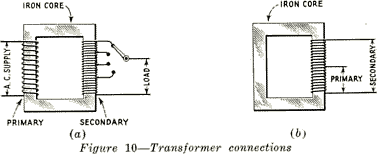Alternating current is best adapted for the transmission of electric power because of
the ease with which it can be changed from one voltage to another. This is important
because electric energy cannot be transmitted efficiently long distances except at high
voltages. Therefore, it is necessary to raise the voltage for transmission and reduce it
again where it is used and, at present, no simple method has been devised for changing
DC voltages up and down for transmission purposes. A common device for changing AC
voltage is known as a transformer.
19. Transformers.- A transformer usually consists of two separate windings on an iron
core (See Figure 9) . It was stated at the beginning of this chapter that when a current is
passed through a wire a magnetic field is formed around the wire, and if an iron bar is
placed in such a field it is magnetized. Magnetic lines of force were described. These lines
extend through the iron as well as through the air, and they form in closed loops, parts of
the loops being in the iron and parts of them being in the air. If the entire path is in iron,
i.e., if we have an iron ring, the number of lines of force are increased because it requires
less magnetizing force to produce lines of force in iron than in air. Earlier in this chapter
it was stated also that if the lines of force which passed through a loop changed in
number, a voltage would be generated in the loop.

Referring to Figure 9 (a), if an alternating voltage is applied across the terminals of
coil "A" an alternating current will pass through the coil. The current will set up lines of
force through the iron, and the number of lines of force set up will be proportional to the
current in the coil at any instant. Since the current is constantly changing, the lines of
force will be constantly changing also. Coil "B" is a series of loops connected together, so
we should expect to have a voltage generated in coil "B" when an alternating current was
flowing in coil "A," and such is the
case. If coil "B" is closed through an external circuit similar to that marked "Load,"
current will flow in the load circuit. Coil "A," or the coil to which the alternating current is
supplied from an outside source, is called the primary. Coil "B," the coil in which the
voltage is generated by the transformer action, is called the secondary of the transformer.
Instead of having only one secondary winding, any number (within practical limits) can be
used so as to supply several circuits at different voltages as shown in Figure 9 (b) .
The voltage generated in the secondary winding depends on the ratio of the number
of turns of the secondary compared with the number of turns of the primary. If the
secondary has twice as many turns as the primary, it will have twice the voltage of the
primary, or if it has one-half the number of turns of the primary, it will have only one-half
the primary voltage. It is therefore possible to obtain any desired voltage within quite a
wide range.
10
